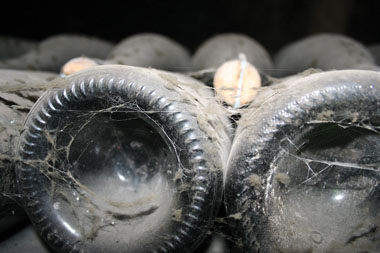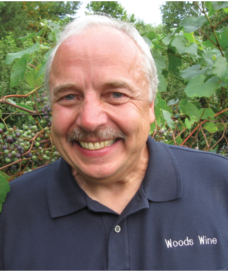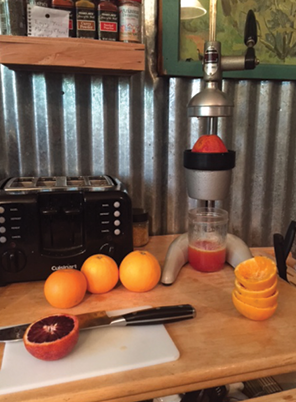
I’m partial to older — much older — wines when it comes to reds. I’m known for not bottling my wines until several years after their vintage.
Red wines aged to their optimum point can exhibit superb balance among acidity, alcohol and tannins with layers of complex flavors and aromas. Drinking such wines in their infancy would be to miss out on the true pleasure these are meant to provide.
Barolo, produced from Nebbiolo grapes, is one such wine and one of my favorites. Barolo has characteristically bold, mouth-drying tannins in its youth, a result of extensive extraction over several weeks of fermentation and a long sojourn in oak barrels. It is seldom approachable until the tannins have softened and have had a chance to become “integrated” into the wine. It may seem rustic when young, but give it 10 years, preferably more if you can, and the wine displays its full greatness.
What about whites? Full-bodied, oak-aged Chardonnay, such as some of the finest Burgundies, are known to age well. High-residual sugar (RS) wines too, such as icewine, can last decades. Sauternes (from the Sauternes region in Bordeaux) and especially Eszencia (from the Tokaj region in Hungary) have such high RS that these wines can last a century or more. So what gives these wines such lasting aging potential? Is it the tannins? Sulfur dioxide (SO2)? RS? Maturation techniques? Cellaring conditions?
These are all factors, but it’s not as straightforward as, for example, simply extracting massive amounts of tannins or adding high doses of sulfite.
Quality and balance
First things first! You cannot expect to make age-worthy wines with compromised fruit. Fruit grown in subpar conditions or which is not allowed to ripen to its optimum may not provide the balance in sugar (and final alcohol), acidity and tannins, among other grape components, to produce age-worthy wines. The ability to make such wines greatly diminishes with the more adjustments you need to make to must or juice. Common culprits are excessive iron or copper, or a nitrogen deficiency. These are measurable parameters but beyond the reach of amateur winemakers. Where available, wine labs provide analytical services, but turnaround time may be too long to address pressing deficiencies.
Similarly, fruit damaged by insects, rot or some disease can never be expected to produce great wines either. Unwanted oxidative enzymes and oxidizable juice compounds may trigger adverse reactions that can negatively affect quality and aging potential. Compromised fruit may also be deficient in glutathione (GSH), a powerful naturally occurring antioxidant in grapes. Careful and meticulous triage at the crusher can minimize these side effects. Commercial yeast-derived products containing GSH can be added as fermentation nutrients.
Beyond these, you have to choose varieties that are known to produce long-lasting wines, either by virtue of their berry physiology (e.g. high tannin content) or because winemaking techniques can turn great grapes into spectacular wines. Red vinifera varieties known to produce wines with lasting power include Nebbiolo, Sangiovese, Cabernet Sauvignon, Syrah, Pinot Noir and Tempranillo. White viniferas to add to this list include Chardonnay, Riesling, and Gewürztraminer.
But you also need to be familiar with the varieties so you know what techniques to use. The varieties listed above span the entire tannin-acidity spectrum from low-low to high-high and may not have that initial balance we are looking for. For example, dealing with high-tannin, high-acidity Nebbiolo will require different techniques than low-tannin, low-acidity Pinot Noir.
Winemaking factors
Beyond their organoleptic impacts, acidity, tannins, free SO2 and oxygen are the most critical factors to monitor and control for making age-worthy wines.
High acidity typically means low pH, and low-pH wines are not only better protected against microbial spoilage, they are chemically more stable over the long run. This means that high-acid wines with lots of clashing tannins will need time to allow the tannins to polymerize and “mellow” for palatability.
Grape skin tannins are natural antioxidants but they also polymerize with anthocyanins (red-pigmented compounds) to form much more stable complexes. So it’s important to balance tannins with anthocyanins so as not to have an excess of leftover unpolymerizable tannins that may make a wine overly astringent and bitter, and possibly very harsh if acidity is also high, or that may cause discoloration. Enologists recommend a ratio of 1.5–2 g/L of tannins to 500 mg/L anthocyanins to maintain adequate color, but unfortunately, amateurs are not yet equipped with the skills or equipment to make such measurements. A guiding principle is to extract more tannins with darker-colored varieties.
This means that an anthocyanin-rich variety like Nebbiolo can be fermented with a post-maceration soak for up to three weeks or more, as is done in Barolo, to extract as much anthocyanins and grape skin tannins as possible. In contrast, Pinot Noir will definitely need barrel aging because of the variety’s limited anthocyanins and tannins.
The rate of tannin polymerization can be reduced using sur-lie techniques. By stirring the lees during the maturation phase, what the French call élevage, mannoproteins are released from the lees, i.e. the dead yeast cells left over from fermentation, which then interfere with tannin aggregation. Aging wine on the lees is also believed to help maintain GSH concentration and therefore improve aging potential. The stirring and aging should not be rushed as racking wine off the lees from barrels has been shown to reduce GSH concentration markedly. And élevage in barrels extracts great amounts of ellagitannins, which have a softer mouthfeel than grape tannins but, more important, they have great antioxidant power.
SO2 and oxygen
The role of SO2 in wine is well understood, or at least winemakers have made SO2 management a routine part of their process. But the same cannot be said for oxygen management, in both amateur and commercial winemaking, and yet, it is more critical towards making great, long-lasting wines.
SO2 management goes beyond measuring free SO2 and then just adding sulfite to get to some desired value based on wine pH. Excessive SO2 can bleach color in reds and mute aromas and flavors.
Free SO2, and more specifically its bisulfite form (HSO3–), binds to carbonyls, acetaldehyde being the most prominent. Bisulfite ions can also bind to o-quinones, brown-colored compounds resulting from polyphenol oxidation. Once bound, SO2 no longer protects wine.
Acetaldehyde is a byproduct of fermentation but can also result from ethanol oxidation. It plays an important role in bridging tannins and anthocyanins to stabilize color in reds. Excessive SO2 can sequester and bind acetaldehyde, away from reacting with tannins and anthocyanins.
Bisulfite ions can become oxidized by oxygen radicals, such as hydrogen peroxide (H2O2), or by o-quinones that may be transformed back into their colorless form.
Oxygen dissolves in wine and enables these oxidation mechanisms by first becoming reduced into its radicals.
This reaction is catalyzed in the presence of iron or copper, and is responsible for the oxidation of polyphenols into their o-quinones.
All these reactions continue as long as there is a supply of oxygen. Adverse reactions that impact organoleptic qualities and aging potential can occur when, for example, SO2 or polyphenols become depleted. These reactions continue while wine sojourns in bottles due to dissolved oxygen (DO) present at bottling, headspace oxygen (HO) that eventually becomes DO, and oxygen that diffuses through closures and into the headspace to eventually become dissolved.
What does this all mean?
If you want to make great, long-lasting wines, you need to manage SO2 and oxygen, and be in tune with your wine’s chemistry. This means measuring free and total SO2 and DO, and making timely adjustments when required.
If you have some apparatus to measure free SO2, such as a Vinmetrica SC-300, chances are that it also measures total SO2. By monitoring the ratio of free to total SO2 you can assess the extent of binding and how effective your sulfiting regimen is for a specific wine. Let’s look at an example.
Consider wines A and B having a free SO2:total SO2 ratio of 10/200 and 35/100, respectively. This data suggests that the sulfiting regimen in wine A is not as effective as in wine B as SO2 additions quickly become bound. That may point to, for example, high levels of acetaldehyde or o-quinones, which may point to a problem of excessive oxygen reaching the wine. Another potential cause of low free SO2 and high total SO2 is an inadequate sulfiting regimen. Few larger sulfite additions are better than many smaller additions. A technique to improve this ratio, particularly when making wine with compromised fruit, is to add thiamin (vitamin B1) at a rate of 0.5 mg/L to must or juice. Thiamin reduces the production of binding compounds and therefore improving free SO2 efficacy.
Oxygen-measuring devices can be quite expensive, but you can purchase a stick-type DO meter, such as the Extech DO600 meter, for the same price as a good free/total SO2 meter. There is no real target DO level during winemaking; the idea here is to monitor changes in DO, such as large spikes, which may give some clue if there are any problems. Every wine will be different, and higher DO levels in reds are expected given that aeration during winemaking and maturation are recommended. DO in whites should always be kept to a strict minimum.
At bottling, all wines should have a DO level of no more than 2 mg/L, ideally at around 1 mg/L, and corked with a good quality closure.
Based on a model developed by wine scientist Richard Gibson of Scorpex Consultancy in South Australia, bottling with 1 mg DO/L instead of 2 can prolong the shelf life of a bottle of wine by 33%, which can be increased to about 71% by purging the headspace with nitrogen. But choosing a closure with an oxygen transfer rate one order of magnitude greater can reduce shelf life by a whopping 82%, and cranking up free SO2 would only have an insignificant impact.
Élevage and cellaring
Élevage conditions of bulk wine and cellaring conditions of bottled wine have significant impacts on aging potential. The most important are temperature, humidity, and lighting.
The ideal temperature is 55 °F (13 °C). Lower temperatures can stifle chemical reactions to a point where the wine may not be evolving at all, and higher temperatures can accelerate these reactions causing the wine to peak prematurely and quite possibly develop flaws.
The recommended relative humidity (RH) is 60–70% to ensure that wine is allowed to evolve slowly and gracefully under the effects of micro-oxidation in barrels. High RH may cause wood to swell so barrels no longer “breathe” as they should. Low RH may cause excessive evaporation of wine through and around barrel staves, which will cause premature oxidation and decreasing amounts of free SO2. The same phenomena occur with cork material and bottled wine.
Wine is also sensitive to the damaging rays of light, particularly ultraviolet (UV) rays from sunlight and fluorescent lighting. Keep carboys well protected during aging, and bottle premium wine meant for aging in dark-colored bottles.
Other than that, continuously monitor the chemical state of your bulk wine, sit back, let the wine take its course.







